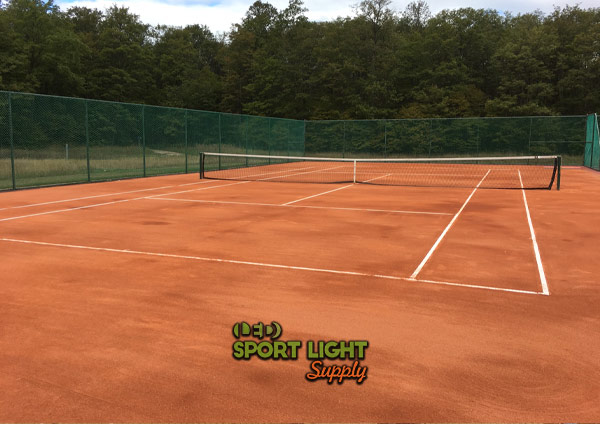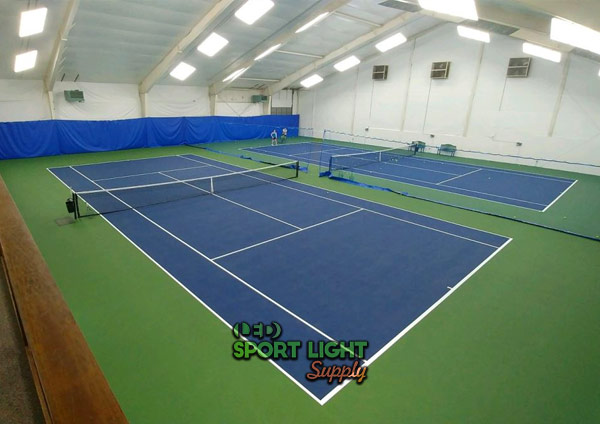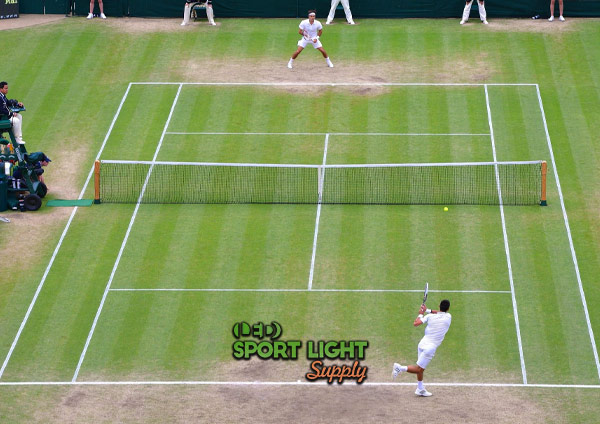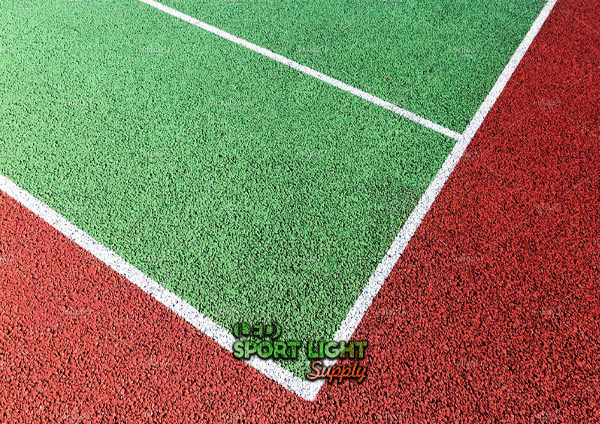There are four primary types of tennis courts: clay, hard, grass, and carpet. How should each of these courts be illuminated? Are there specific guidelines or considerations to keep in mind when installing lighting for tennis courts? If these questions have crossed your mind, this article is here to help. Additionally, we will explore the unique characteristics of these four court types, including aspects like ball bounce, shock absorption, friction, and more.
Table of Contents
ToggleClay Court

Characteristics
Clay courts vary in color depending on the country of origin, but the texture remains relatively consistent across different regions. European and South American courts commonly use crushed brick and shale or basalt. Red clay courts are typically made from crushed brick and shale, while blue clay courts are composed of basalt and crushed brick. The surface is then smoothed using a heavy roller to ensure an even playing field.
Effect on Tennis Players and Ball Bounce
Clay courts are well-suited for players who excel in defensive strategies, as the surface allows for easier sliding into returns. The ball bounce on clay courts is generally higher but slower compared to other surfaces, which can benefit defensive players. However, the slower surface can be a disadvantage for players who rely on powerful serves and aggressive play, as the clay tends to reduce the speed and impact of the ball, giving an edge to the defensive player.
How Clay Surfaces Affect Lighting and Performance
One of the advantages of clay is its non-reflective nature, which helps absorb light effectively. However, since clay is a natural material, it often kicks up dust, especially during intense matches. This dust can create a hazy effect under outdoor lighting until it settles, potentially impairing visibility. Synthetic clay surfaces are more suitable for lighting as they are bonded to the court floor, reducing dust and providing better grip. Despite this, the powder-like dust from natural clay can linger in the air, making the court appear foggy in certain spots, which could impact the players’ visual depth during a match. While clay is commonly used outdoors, it is better managed indoors where moisture levels can be controlled more effectively.
Hard Court

Characteristics
Hard courts are constructed using a variety of materials, with the base often being concrete or asphalt. A layer of synthetic material mixed with sand is typically added to enhance the texture and provide better grip for players. The surface can be painted in various colors, including red, green, or blue, with the sandy texture helping to add friction for improved playability.
Effect on Tennis Players and Ball Bounce
Hard courts offer less absorption, resulting in faster play with higher ball bounces. This surface allows players to utilize spin effectively to gain an advantage. The amount of impact absorption depends on the thickness of the sand coating, with thicker layers providing more friction and leading to slower bounces. Due to their balanced characteristics, hard courts are often referred to as “Democratic courts,” as they cater to a wide range of playing styles and are popular among tennis players.
How Hard Surfaces Affect Lighting and Performance
Hard courts are highly compatible with outdoor lighting due to their artificial texture, which absorbs light effectively. The textured sand on the surface helps illuminate the court’s color, making it easier to spot the ball during play. Unlike smoother surfaces, hard courts with sand-based paint do not produce glare, as the sand particles deflect light waves and absorb them directly. Even asphalt surfaces are commonly coated with special tennis court paint that includes sand, ensuring optimal lighting conditions for both indoor and outdoor use.
Grass Court

Characteristics
Grass courts offer a unique playing experience, as the surface is softer than hard courts. However, the playing conditions on grass courts can vary significantly depending on factors such as soil compaction, grass maintenance, and moisture levels. These elements influence the ball’s bounce, which can differ from one match to another based on the court’s condition.
Effect on Tennis Players and Ball Bounce
Grass courts generally produce faster but lower ball bounces due to the density of the soil and grass. This gives an advantage to players with strong serves, although volley shots can be effectively returned by defensive players. Grass courts are also conducive to sliding into shots, but they can become slippery when wet, particularly during rain. The Wimbledon Grand Slam, known for its grass courts, often faces challenges with scattered showers and poor weather conditions, affecting the playability of the surface.
How Grass Surfaces Affect Lighting and Performance
Grass surfaces present a challenge for lighting due to their reflective properties. The blades of grass, being smooth and slick, can create glare under certain lighting angles. As players move across the court, the angle of the grass blades changes slightly, causing light to reflect differently and potentially creating blind spots or reflective patches. Additionally, moisture on the grass, such as dew, can make the surface glisten under the lights, increasing the likelihood of glare and making the court slippery. The reflective nature of grass and its tendency to retain moisture can complicate nighttime play, as the grass blades’ position and moisture levels are constantly changing.
Carpet Court

Characteristics
Carpet courts are versatile surfaces that can be rolled out onto standard hard courts. They are designed to simulate the feel of grass with varying thicknesses, similar to Astroturf. Carpet surfaces are commonly used for indoor tennis courts but have been banned by the Association of Tennis Professionals (ATP) from use in official tournaments.
Effect on Tennis Players and Ball Bounce
Carpet courts share similarities with grass courts in terms of how they absorb the ball’s energy. Serves tend to be faster and lower, which can benefit players who excel in volleying. However, regular tennis shoes are not recommended on carpet courts, as they can cause injuries due to the increased grip. Special shoes designed for carpet courts provide better slide control. The performance of the carpet also depends on its thickness and age, with older or more compacted carpets potentially affecting the ball’s bounce and players’ movement.
How Carpet Surfaces Affect Lighting and Performance
Carpet surfaces are typically matt-colored, which helps minimize glare. However, over time, compacted areas of the carpet can become slightly reflective, particularly if the material is made from plastic or artificial turf. Regular cleaning with industrial carpet cleaners can help maintain the surface’s texture and reduce reflectivity. While carpet courts are generally less prone to glare, older artificial turf surfaces can become reflective as they wear down, particularly in outdoor settings where reflectivity can be more problematic.
Conclusion
Each type of tennis court—clay, hard, grass, and carpet—offers unique playing experiences and poses distinct challenges for lighting. Understanding the characteristics of each surface and how they interact with lighting can enhance both the performance and enjoyment of the game, ensuring optimal conditions for players and spectators alike.
